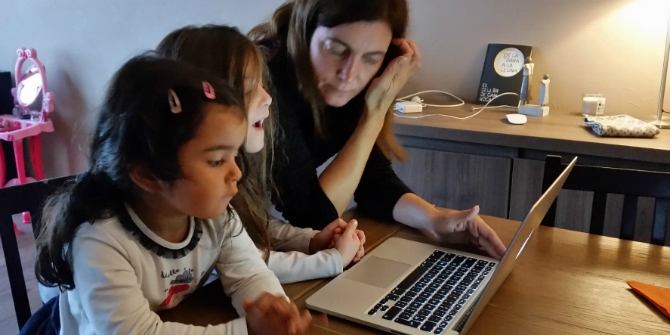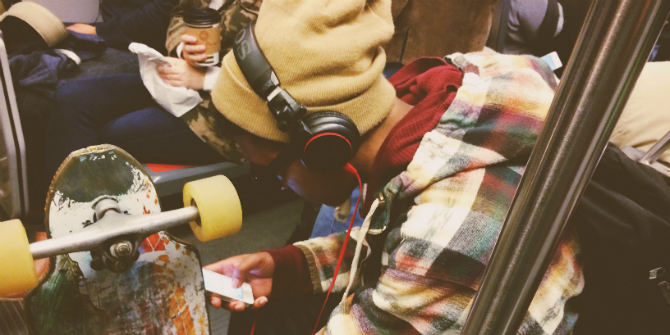 In the third of four posts presenting findings from the Makerspaces in the early years (MakEY) final report, Sonia Livingstone, Alicia Blum-Ross, and Paige Mustain discuss why, despite claims of “tech-free” parenting among tech-elite parents, they are eager to benefit from makerspaces provided for young children.
In the third of four posts presenting findings from the Makerspaces in the early years (MakEY) final report, Sonia Livingstone, Alicia Blum-Ross, and Paige Mustain discuss why, despite claims of “tech-free” parenting among tech-elite parents, they are eager to benefit from makerspaces provided for young children.
There has been a rising trend among tech elites of ditching digital devices at home. “Bill Gates and Steve Jobs raised their kids tech-free” was a popular headline for news stories two years ago. The trend is proven by the enrolment of the children of tech industry parents in unconventional low-tech schools such as Brightworks in San Francisco and the many Waldorf schools across the country. These schools are known for their emphasis on creative play and a strategic lack of technology based on the belief that kids learn best through playful, learner-led approaches. Interestingly, these playful learner-led approaches shape the same philosophy that the makerspace movement has grown out of. However, a central component of makerspaces [1] has been the access to digital fabrication and open electronics resources. So why would Silicon Valley parents seek out makerspaces for their children?
Over the last two years we have been researching how parents support their young children (three- to ten-year-olds) to learn in Silicon Valley makerspaces as part of an international research project called Makerspaces in the Early Years (MakEY) [2]. What we found is that tech-elite parents seeking makerspaces don’t really focus on the technology but are keen to cultivate creativity and messy play in a safe place, away from what they view as the harms of unfettered technology use. One could even argue there is a distinct synergy between the ethos of the makerspace and that of early years’ learning (even though most makerspaces are for adults, as is most research about them).
Makerspaces range from no- to high-tech but the ones we observed in Silicon Valley all relied on technological resources to a greater or lesser degree. And despite claims of “tech-free” parenting among tech-elite parents, we found them eager to benefit from makerspaces provided for young children. Although seemingly contradictory, as noted in our previous work, parents attempting a deliberately low-tech home draw a distinction between productive uses of technology and “mindless” screen time. As they told us, on the one hand, they restrict technology use at home but, on the other, they see makerspaces as opportunities for children to engage with the technological resources in a more controlled way that, as they see it, is productive rather than “socially destructive.” Indeed, despite restricting technology at home, these parents still recognised the importance of digital skills today. Their aim is to stave off technology as long as possible, building their child’s other skills first in the hope that they would be sufficient to ensure later responsible and safe use of technology. One mum explained:
“I’m not a Luddite, I mean, I’m just trying to protect, really, their space and their ability to have new experiences, because I know eventually I’m going to be, they’re going to be in that world inevitably.”
Discussing his views on technology while echoing the ethos of makerspaces where creativity and collaboration are central, one dad that works in tech said:
“What’s going to differentiate the humans from the internet is the ability to think and solve problems and work collaboratively with other people and social intelligence. So I want him to learn all of that stuff, and be good at that stuff. So I want him to be creative and think critically, solve problems, know how to get along with people, be a good teammate. That’s far more important to me.”
Another mum valued the makerspace less for its messy creativity, therefore, and more for helping with needed skill development:
“I think free play is important, but, like with drawing right now is giving him fine motor skills, so that he can actually use the pencil. I’m just trying to expose him to those things to get those skills that he’s going to need.”
Our previous work within the Connected Learning framework led us to wonder how parents themselves connect their child’s sites of learning in the face of the seeming contradiction between minimising tech use at home while driving children to out-of-school tech-rich learning activities. Their explanations reveal how parents find a rationale that provides continuity as well as connection across sites. For instance, some parents we spoke with, including one who has their child in a Waldorf school, said they use makerspaces as the STEM portion or as a supplement for their children’s education. Others emphasise creative play at home, saying that their motivation for visiting the makerspace was not about the technology at all, but about continuing to foster creativity. One parent explained:
“Generally his world is playing with balls and trucks and cars. It’s really hard for me to get him engaged in creative or artsy things. He doesn’t like to draw. Whenever I try to get him into that sort of more creative, design or anything, I try to incorporate cars or planes or balls. So I thought this would be perfect…But I love how innovative it is from like drawing the picture and then using the tablet.”
A dad added, “And it’s not about learning, the effort around learning. It’s really about something where you can experiment on your own level.”
Also important to Silicon Valley parents seeking out makerspaces is that they think makerspaces can help cultivate their children’s interests to help them become creators rather than consumers in the digital age. One parent conveyed how they felt the makerspace helps their child become a creator by saying:
“And so you become the person who creates whatever the next thing is, rather than being like, oh this button is for that, which I think limits your mind.”
Indeed, empowerment is a common phrase used to describe the benefits of makerspace learning. It is usually meant to describe the freedom to explore and tinker. In other words, it represents the learner-led exploratory learning makerspaces are built upon rather than traditional rote learning in school. Several parents expressed this as “holistic” or “organic” learning:
“But honestly, we are more like, we want to give a more organic learning.”
So while they tend to control technology use at home and encourage it in the makerspace, their “parenting philosophy” (whether for STEM or creative learning or, most abstractly, for autonomy or empowerment) bridges these different learning sites in ways meaningful within the family.
These varied motivations highlight the openness of makerspaces, able to cultivate a wide-range of skills and interests both with and without the use of technology. Regardless of parents’ views on technology, most were enthusiastic about makerspaces’ cultivation of creativity. Makerspaces present themselves as unique sites to foster creative learning while potentially developing those important digital skills. Despite the growing low-tech trend among tech elites there is still recognition from those parents of the importance of those skills in today’s digital age. However, the wide range and level of tech use observed at makerspaces alongside the varied motivations among parents makes us wonder if the technology itself is a vital component or if the same can be accomplished without it.
Notes
[1] Makerspaces are collaborative work spaces that allow everyone from young children to adults to learn, explore, and experiment through making. While there is a wide range of tools within them, many makerspaces have a variety of maker equipment such as laser cutters and 3D printers. These tools are often used alongside art materials such as cardboard, LEGO, and tape.
[2] The MakEY project is an international research project led by Professor Jackie Marsh from the University of Sheffield. It brings together researchers looking at the benefits and challenges of running makerspaces in formal and informal educational settings. The goal of the project is to advance understandings of the role of makerspaces in young children’s digital literacy and creativity development.
This article represents the views of the author, and not the position of the Parenting for a Digital Future blog, nor of the London School of Economics and Political Science.





